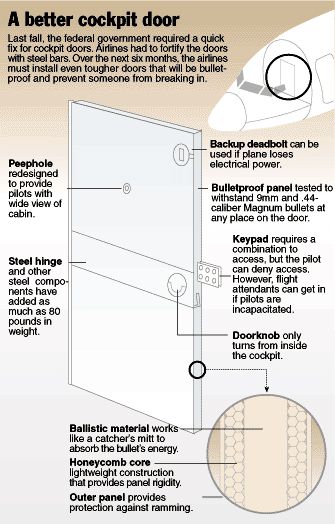Fri, Feb 17, 2017
Says Hardened Deck Doors Are Only A Partial Solution To Cockpit Security
The downing of four commercial airplanes and loss of nearly 3,000 lives on 9/11 was due, in part, to inadequate protection of the aircraft flight deck. Shortly after 9/11, Congress and the FAA required the installation of hardened flight deck doors on most commercial airline aircraft as one of many new layers of security. The hardened flight deck doors are an important improvement to security, but they are not a complete solution to preventing unauthorized individuals from entering the flight deck. The flight deck door must be opened during flight to provide for pilots’ biological needs and for operational requirements related to safety.

As events have demonstrated, Americans still remain vulnerable to terrorist attacks. There have been at least 52 hijacking attempts around the world since 9/11. The U.S. government has repeatedly and recently confirmed that aviation, in particular, is still a target of radical terrorists and the threat of hijackings is real.
Since 2003, two major airlines have voluntarily installed a lightweight, inexpensive wire mesh, called a flight deck secondary barrier, on hundreds of their aircraft, which is permanently mounted between the flight deck door and the cabin. Boeing and Airbus offer the secondary barrier as equipment on new aircraft. Installation of retrofitted secondary barriers on aircraft already in the fleet represents a minimal cost, as they can be added at a cost of approximately $5,000 per aircraft or even less.
During the 114th Congress, legislation was introduced in both the House and Senate (i.e., H.R. 911 and S. 911) to address this issue by mandating secondary barriers for all commercial passenger operations. A version of these bills, which mandated secondary barriers on all new aircraft, was included in both the FAA reauthorization bill that passed the full Senate and the House counterpart that passed out of committee. (Note: The House never voted on a full FAA reauthorization on the floor during the 114th Congress.)
(Source: ALPA news release)
More News
With Testing Soon Complete, Launch Preparations Begin in Earnest Sierra Space's Dream Chaser has been put through the wringer at NASA's Glenn Armstrong Test Facility in Ohio, but w>[...]
Takeoff Roll The process whereby an aircraft is aligned with the runway centerline and the aircraft is moving with the intent to take off. For helicopters, this pertains to the act>[...]
“We’re proud of the hard work that went into receiving this validation, and it will be a welcome relief to our customers in the European Union. We couldn’t be mor>[...]
"Aircraft Spruce is pleased to announce the acquisition of the parts distribution operations of Wag-Aero. Wag-Aero was founded in the 1960’s by Dick and Bobbie Wagner in the >[...]
IDENT Feature The special feature in the Air Traffic Control Radar Beacon System (ATCRBS) equipment. It is used to immediately distinguish one displayed beacon target from other be>[...]
 Sierra Space Repositions Dream Chaser for First Mission
Sierra Space Repositions Dream Chaser for First Mission ANN's Daily Aero-Term (05.10.24): Takeoff Roll
ANN's Daily Aero-Term (05.10.24): Takeoff Roll Aero-News: Quote of the Day (05.10.24)
Aero-News: Quote of the Day (05.10.24) Aero-News: Quote of the Day (05.11.24)
Aero-News: Quote of the Day (05.11.24) ANN's Daily Aero-Term (05.11.24): IDENT Feature
ANN's Daily Aero-Term (05.11.24): IDENT Feature



